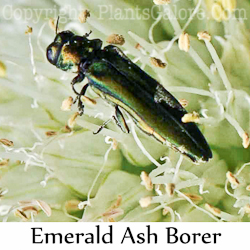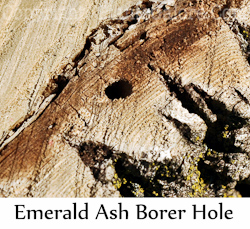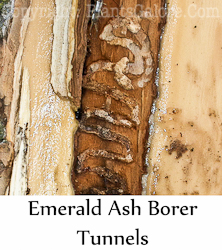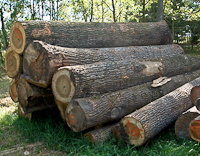|
 In 2002, scientists from
Michigan State University discovered the cause
of a recent decline and death of many ash (Fraxinus) trees in
Southeast Michigan. It was discovered that the dead trees where infested
with a new insect which was subsequently identified as coming from
China
and was given the common name, Emerald ash borer or EAB. The name comes
from the fact that the smallish insect is an iridescent green or
emerald in color. In 2002, scientists from
Michigan State University discovered the cause
of a recent decline and death of many ash (Fraxinus) trees in
Southeast Michigan. It was discovered that the dead trees where infested
with a new insect which was subsequently identified as coming from
China
and was given the common name, Emerald ash borer or EAB. The name comes
from the fact that the smallish insect is an iridescent green or
emerald in color.
The theory is that the insect was introduced into the area inside wooden
packing crates that came from China. These were evidently made of ash
wood that had not been kiln dried or otherwise treated to kill grubs
inside the boards. The crates were subsequently dumped into a landfill
where the grubs matured, and flew off to infest the nearest ash trees.
Nobody knows the exact date when the insects were introduced.
 Unlike native borer insects which almost universally attack old,
stressed trees, EAB infests young, vigorous plants. Like other exotic
pests, it thrives in its adopted land because there are no natural
predators or diseases that keep it under control. So, it has gone wild
and, to date, has killed many millions of ash trees in the Midwest. It
is still on the move and there is no current reason to believe that it
will not continue to devastated ash trees throughout their natural
range. Unlike native borer insects which almost universally attack old,
stressed trees, EAB infests young, vigorous plants. Like other exotic
pests, it thrives in its adopted land because there are no natural
predators or diseases that keep it under control. So, it has gone wild
and, to date, has killed many millions of ash trees in the Midwest. It
is still on the move and there is no current reason to believe that it
will not continue to devastated ash trees throughout their natural
range.
Ironically, it is estimated that the EAB would only spread a very short
distance each year on its own. It is not a strong flying insect so it
would move slowly from woodlot to woodlot. So why has it become such a
devastating pest?
Unfortunately, although it may move only a mile or two per year on its
own, EAB is capable of traveling at speeds of 70 miles per hour or
more...in the back of a pickup truck or automobile. The key way EAB is
being spread is in firewood.
 When dead, infested ash trees are cut down, the larvae of EAB continue
to live inside. If the wood is not burned quickly, the larvae will
continue to grow, turn into adults, chew their way through the bark and
fly away. People taking firewood from infested areas to campgrounds,
cabins or other places unwittingly spread the critter. Sadly, even
though movement of firewood has been banned, a certain segment of the
population still transport it anyway. When dead, infested ash trees are cut down, the larvae of EAB continue
to live inside. If the wood is not burned quickly, the larvae will
continue to grow, turn into adults, chew their way through the bark and
fly away. People taking firewood from infested areas to campgrounds,
cabins or other places unwittingly spread the critter. Sadly, even
though movement of firewood has been banned, a certain segment of the
population still transport it anyway.
 So, what can we do about EAB. Sadly, the answer is that many, many more
millions of ash trees will die before a solution may be found and
implemented. In the home landscape, individual ash trees that are vital
to the garden may be protected by treatment with systemic
insecticides.
These chemicals are either drenched into the root zone of the tree or
mechanically injected beneath the bark. This must be done every
year...basically forever, at least as it stands now. The treatments cost
money and they must be initiated BEFORE the tree starts showing signs of
infestation. So, what can we do about EAB. Sadly, the answer is that many, many more
millions of ash trees will die before a solution may be found and
implemented. In the home landscape, individual ash trees that are vital
to the garden may be protected by treatment with systemic
insecticides.
These chemicals are either drenched into the root zone of the tree or
mechanically injected beneath the bark. This must be done every
year...basically forever, at least as it stands now. The treatments cost
money and they must be initiated BEFORE the tree starts showing signs of
infestation.
Update 2013: In a radio interview, Dr. Deb
McCullough of Michigan State University gave a nice update on EAB.
-
They now think that
EAB was probably introduced into Michigan as long
ago as the late 1980's. It takes several years for
the insect to build to levels that are needed to
kill an ash tree.
-
She mentioned that
EAB is now found in 22 states and is spreading
throughout the natural range of ash (Fraxinus)
trees.
-
Federal scientists
are trying to find and introduce natural enemies to
the EAB. This includes species of parasitic wasps.
If this is to work at slowing down the destruction,
it will take many, many years for these critters to
build to large enough populations.
-
In areas with well
established populations of EAB, 85 to 99% of the ash
trees are eventually killed.
-
Treatment of
individual or small groupings of ash trees in the
home landscape may be protected by systemic
insecticide treatments. Unfortunately, these may be
somewhat expensive and must be applied every year on
trees that do not yet show any signs of damage from
EAB.
|



